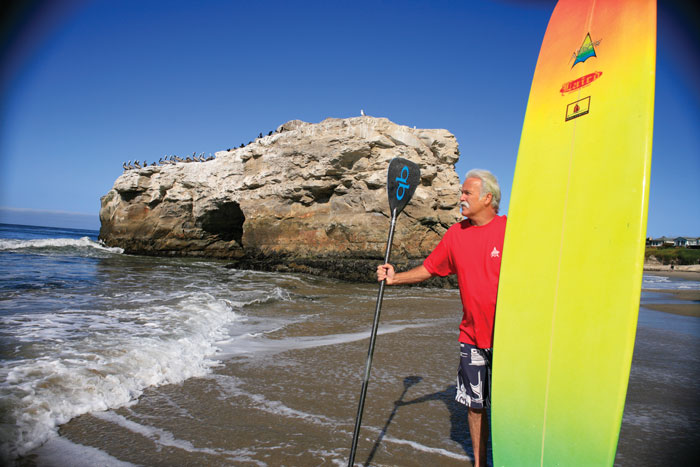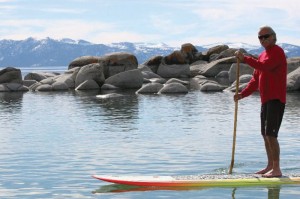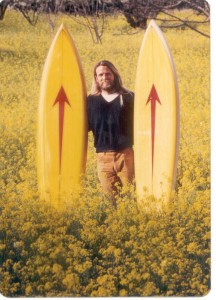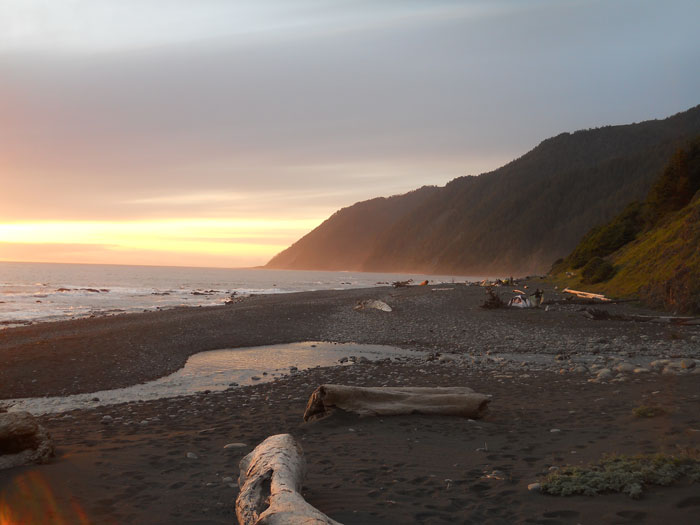- Tahoe’s Nevada Beach Tops the List of Hard-to-Book Campgrounds - 07/17/2024
- Cannabis Watershed Protection Program Cleans Up Illegal Grow Sites - 07/10/2024
- French Fire - 07/05/2024
When it comes to SUPs, Bob Pearson is all about having fun and getting exercise
By Neil Pearlberg
Bob Pearson of Arrow Surfboards is shaping the future of the surf industry. Since 1966 he has built over 75,000 boards, all adorned with the famed Arrow logo, and the man’s renowned love of the ocean and influence on the California culture that surrounds it continues to grow.
In other words, Bob Pearson just gets it.
He understands what the ocean can do for a man or a woman. He knows and relishes the ocean’s allure for people. He sees it as a way to appreciate life, a place to play and enjoy while with your children. Above all he respects its power, its danger, and all of its glory.
“Bob has been a mentor for many young surfers for over thirty years, and given many the opportunity to become pro surfers by making them the finest surfboards; or employing them at his surf shop or surfboard factory,” says big wave surfer and longtime Arrow rider, Ken “Skindog” Collins.
The Arrow Surfboard method is simple. You take a seat with Pearson at his factory to discuss the type of board that you would like him to design and shape for you, and slowly but surely, you will find yourself bathing
in his knowledge, and fully immersed in his passion.
Notes will be taken, and the date set for your new board. You shake the tall man’s hand as you leave his shaping room on the east side of Santa Cruz, and it is then that you will find yourself driving away, grinning from ear to ear.
It is the effect of a master craftsman.
Bob Pearson has created some very popular board designs over the last three decades. In the last ten years, his stand up paddleboard (SUP) designs have become especially popular.
Laird Hamilton’s New Toy
The year 2000 marked not only the beginning of a new millennium, but a fateful trip to Southern California where Pearson met with his friend Laird Hamilton, who was about to introduce him to an idea that would eventually take the world by storm, and become the world’s fastest growing water sport.
Accompanying Pearson to Southern California was ex-NFL star linebacker Bill Romanowski. Early one Malibu morning Pearson and Romanowski were waiting for Hamilton, and they were chomping at the bit to ride the six-foot surf at Point Dume. Hamilton was going to join them both in the line up later.
“Romo (Romanowski) and I surfed for about two hours, then we both headed to the beach.” Pearson said. “What I saw next blew my mind.”
“A hundred yards down the beach, there was the unmistakable figure of Laird standing on a board, with a long paddle in his hand and heading towards the lineup.” Pearson recounts.
“How cool,” commented Romanowski.
Pearson remained unfazed, knowing to expect the unexpected from Laird Hamilton, who always sought to keep things fresh and real.
What happened next made a large impression on Pearson, as Laird drove his paddleboard through the same sections that just a few minutes ago Pearson couldn’t make on his high performance longboard.
“I credit myself as a damned good surfer, and I knew it wasn’t just Laird’s ability that was allowing him to make it all the way though the breaking waves—it was the paddle that made it possible,” he explains.
The SUP comes to California
“It looked so cool yet crazy that this guy was standing on a board using a paddle while doing things that couldn’t be done on a regular surfboard. Right then and there I realized the power of SUP.”
Pearson and Hamilton share the same love of the water, and especially the joy of utilizing nontraditional methods to play in it. Be it a boogie board, air mattress, hydrofoil board, or surfboard, it matters not; the ocean is all about having the most fun possible. After witnessing Laird on an SUP, Pearson knew that stand up thing might really become popular.
Little did they know…
On his last six-footer, Hamilton drove the board across the wave, faded left, then hung five toes over the front. Stepping off onto the beach right in front of Pearson and Romanowski, he said. “Hey Bob, you have to try this!”
Pearson couldn’t wait, and after a couple of tips, he grabbed the board and paddle and headed out. “The approach was so different from anything I had ever done. The perspective of standing on the board, seeing all the fish, here was a new way I could involve myself in the ocean…and I loved it,” said Pearson emphatically.
Before they left the beach Pearson and Hamilton convened in the sand and traded ideas about this new board sport. Later, after going into production, Rick Thomas, a Hawaiian friend of Bob’s, suggested the name Hoe Nalu He’e (stand up paddle wave ride). So Bob and Arrow started calling them Hoe’s for short.
On the five hour drive back to Santa Cruz, Pearson looked back on his prior windsurf knowledge and tandem surfboard designs. His mind buzzing with not only ocean riding, but the infinite flat water potential of the Hoe Nalu, he couldn’t wait to get to his shaping room on the east side of Santa Cruz.
The Naysayers
“We just kicked the door wide open to a new chapter for surfboard manufacturers,” said Pearson. “Now riding a surfboard was not limited to riding waves; anyone who could get to a body of water was able to live their own California dream.
Like anything new, a few naysayers and detractors were out to discredit the Hoe Nalu, or “stand up paddleboard” as it came to be known. In the same manner of surfing’s return to the longboard, or snowboarding’s introduction to ski resorts, the SUP shook the surf community to its core.
Pearson was amused by the rhetoric surrounding SUPs, and how similar it sounded to the pronouncements from a minority of skiers who were all bent out of shape by snowboarding ten years earlier.
“I am never going to ride one of those things, or I am never going to ride a snowboard, they are ridiculous,” said Pearson laughing, and who continued, “Next thing you know they are riding one, and they think it’s cool.”
Pearson notes with a twinkle in his eye that it is the same hard core local Santa Cruz surfers discrediting paddle boarding, who later call him on a flat surf day and say, “Hey Bob, can I borrow a paddleboard?”
“Now, I can’t get them off of one!” says Pearson with a wry smile.
SUPs Get Competitive
The highly competitive sport of SUP racing on both flat water and downwind has become a multi-million dollar industry, with elite athletes competing for large purses, and manufacturers seeking the fastest athletes to propel their latest and greatest board.
Whether on the ocean, rivers, or lakes, SUP shapes are evolving quickly. The design and construction of the paddle board—and paddle—has moved at a lightning pace with computer aided design (CAD), and the use of lighter and stronger carbon fiber materials and composites.
Extraordinarily light displacement hulls, penetrating bows, multi-hulls—the search continues for faster entry and release through the water as each paddler defines his precise stroke for maximum glide.
Pearson recalled his first trip in 2005 to introduce stand up paddle boarding to Lake Tahoe to his friend Ernie Brassard. “We paddled around the south shore and down the Truckee…having never seen this before people on the bank were literally laughing at us, as we negotiated the rocks of the running river.”
The following year Pearson returned to Tahoe to see Brassard, where together they organized the world’s first-ever stand up paddle board race, named the Tahoe Nalu. Today the “Nalu” has become one of the foremost races on the schedule, with hundreds of competitors and elite paddlers duking it out for the $10,000 prize money, a far cry from the inaugural race that involved beer, bikinis, and boats.
The Future
With sailing’s America’s Cup slated to take place this summer in San Francisco, it means the arrival of not only futuristic technology for sailboats, but for other water craft as well. Paddle board shapers will be paying close attention, as they strive to unlock the secret of mass versus the water, to attain faster speeds from their craft.
“The future of SUP is futuristic designs that are going to blow people’s minds,” says Pearson. “I love the freshness of change, and the ability to keep things moving.”
It is said credit should lie where credit is due. Bob Pearson is the first to explain that credit for the SUP phenomenon lies neither with Laird Hamilton nor himself.
“The ancient Babylonians, the Brazilian Amazon Natives, the Chinese river riders, the Hawaiians—these were the earliest to step onto a platform with a paddle. I just happen to be lucky enough to be associated with the modern design,” Pearson said.




















